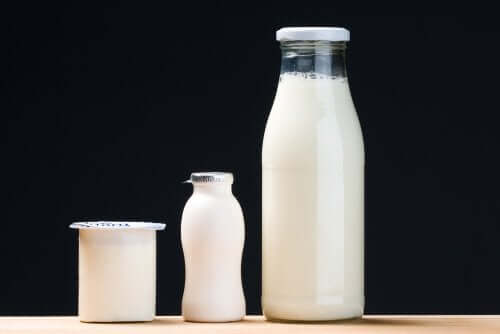5 Facts About Lactose that You Should Know


Written and verified by biochemist Luz Eduviges Thomas-Romero
Lactose is made up of glucose and galactose, two simple sugars that the body uses directly as a source of energy and more. Therefore, in this article we’re going to present 5 facts about lactose that you should know.
5 facts about lactose that you should know
1. Lactose production takes place exclusively in the mammary glands
First on our list of facts about lactose is the fact that only breast cells can produce this sugar, which is a type of sugar known as a “disaccharide.” This means it’s made up of two simple sugar molecules that are chemically linked: glucose and galactose.
Humans can’t absorb this double sugar when it’s intact, so our bodies need to break that link between the individual sugar molecules. Once glucose and galactose are released, the body absorbs them easily.
The enzyme lactase, which is produced in the cells of the intestine, is responsible for the breakdown of lactose. When the enzyme lactase isn’t present enough in the intestine, the sugar reaches the large intestine intact. There, it interacts with bacteria, creating the uncomfortable symptoms of lactose intolerance.

2. The ability to use lactose is limited in nature
This feature isn’t necessarily a limitation, rather, it looks like an evolutionary advantage for mammals. We should keep in mind that the most abundant carbohydrates in nature contain concatenated units of glucose. This combines with the fact that bacteria, the most abundant living things in nature, love to eat sugars. Thus, most bacteria possess the necessary machinery to process this type of sugar.
In this context, only bacteria that have the ability to digest lactose could colonize milk, either in the mammary gland or in the baby’s digestive tract. Therefore, the fact that lactose contains glucose/galactose may have offered a protective effect.
3. Disaccharide digestion involves more than just supplying energy
The galactose that releases as a result of sucrose digestion has several biological functions. For example, it’s part of several macromolecules that make up the membrane of nerve cells, such as cerebrosides, gangliosides, and mucoproteins.
In addition, galactose is also a component of the molecules present in blood cells that determine ABO blood groups.
4. Lactose content differs from one species to another
It’s easy to assume that the milk of each species has a composition that’s very closely adapted to the needs of its young. In human milk, lactose is the most abundant component.
Human milk contains 7.2% lactose, one of the highest concentrations of sugar in mammalian milks. Surprisingly, it’s not cow’s milk but zebra’s milk, with 7%, that most closely resembles human milk.

Experts recognize that the production of lactose in each species is intimately linked to its evolution and the ecological niche it occupies. Species that fast during lactation, including bears and whales, produce milk with very little lactose. On the other hand, species that lactate for long periods, such as humans, produce milk with a higher concentration of lactose.
Thus, if you have difficulty digesting the lactose in cow’s milk, you’d need to avoid drinking monkey’s milk as well, as it contains 8% lactose. On the other hand, seals produce milk that’s almost lactose free. But watch out, because it also contains 70% fat with a fishy taste. So, it’s probably not the most appetizing option to combine with your cereal!
5. A secret sweet: Industrial use
In addition to food sources of lactose, we find this sugar in small amounts in a wide variety of medications. This use is common due to its excellent properties as a compression excipient.
For this reason, this disaccharide is a frequent component in medicines that come in the form of tablets. However, it’s also available in other pharmaceutical forms, such as capsules or sachets.
However, research has shown that amounts below one gram are harmless to those who don’t digest this sugar well. Therefore, it’s important to know that, in most medicines, there are only a few milligrams of lactose, at most.
Lactose is made up of glucose and galactose, two simple sugars that the body uses directly as a source of energy and more. Therefore, in this article we’re going to present 5 facts about lactose that you should know.
5 facts about lactose that you should know
1. Lactose production takes place exclusively in the mammary glands
First on our list of facts about lactose is the fact that only breast cells can produce this sugar, which is a type of sugar known as a “disaccharide.” This means it’s made up of two simple sugar molecules that are chemically linked: glucose and galactose.
Humans can’t absorb this double sugar when it’s intact, so our bodies need to break that link between the individual sugar molecules. Once glucose and galactose are released, the body absorbs them easily.
The enzyme lactase, which is produced in the cells of the intestine, is responsible for the breakdown of lactose. When the enzyme lactase isn’t present enough in the intestine, the sugar reaches the large intestine intact. There, it interacts with bacteria, creating the uncomfortable symptoms of lactose intolerance.

2. The ability to use lactose is limited in nature
This feature isn’t necessarily a limitation, rather, it looks like an evolutionary advantage for mammals. We should keep in mind that the most abundant carbohydrates in nature contain concatenated units of glucose. This combines with the fact that bacteria, the most abundant living things in nature, love to eat sugars. Thus, most bacteria possess the necessary machinery to process this type of sugar.
In this context, only bacteria that have the ability to digest lactose could colonize milk, either in the mammary gland or in the baby’s digestive tract. Therefore, the fact that lactose contains glucose/galactose may have offered a protective effect.
3. Disaccharide digestion involves more than just supplying energy
The galactose that releases as a result of sucrose digestion has several biological functions. For example, it’s part of several macromolecules that make up the membrane of nerve cells, such as cerebrosides, gangliosides, and mucoproteins.
In addition, galactose is also a component of the molecules present in blood cells that determine ABO blood groups.
4. Lactose content differs from one species to another
It’s easy to assume that the milk of each species has a composition that’s very closely adapted to the needs of its young. In human milk, lactose is the most abundant component.
Human milk contains 7.2% lactose, one of the highest concentrations of sugar in mammalian milks. Surprisingly, it’s not cow’s milk but zebra’s milk, with 7%, that most closely resembles human milk.

Experts recognize that the production of lactose in each species is intimately linked to its evolution and the ecological niche it occupies. Species that fast during lactation, including bears and whales, produce milk with very little lactose. On the other hand, species that lactate for long periods, such as humans, produce milk with a higher concentration of lactose.
Thus, if you have difficulty digesting the lactose in cow’s milk, you’d need to avoid drinking monkey’s milk as well, as it contains 8% lactose. On the other hand, seals produce milk that’s almost lactose free. But watch out, because it also contains 70% fat with a fishy taste. So, it’s probably not the most appetizing option to combine with your cereal!
5. A secret sweet: Industrial use
In addition to food sources of lactose, we find this sugar in small amounts in a wide variety of medications. This use is common due to its excellent properties as a compression excipient.
For this reason, this disaccharide is a frequent component in medicines that come in the form of tablets. However, it’s also available in other pharmaceutical forms, such as capsules or sachets.
However, research has shown that amounts below one gram are harmless to those who don’t digest this sugar well. Therefore, it’s important to know that, in most medicines, there are only a few milligrams of lactose, at most.
All cited sources were thoroughly reviewed by our team to ensure their quality, reliability, currency, and validity. The bibliography of this article was considered reliable and of academic or scientific accuracy.
- Pereira, P. C. (2014). Milk nutritional composition and its role in human health. Nutrition, 30(6), 619-627.
- Oftedal O.T. 1997. Lactation in whales and dolphins: evidence of divergence between baleen- and toothed-species. Journal of Mammary Gland Biology and Neoplasia 2: 205–230.
- Milligan Newmark, L., (2017). Milk Lactose From A to Zebra. in SPLASH! milk science update International Milk Genomics Consortium
This text is provided for informational purposes only and does not replace consultation with a professional. If in doubt, consult your specialist.








